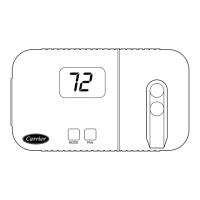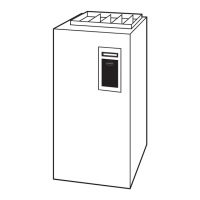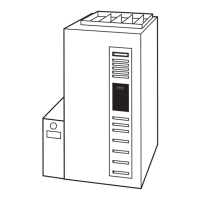This gas furnace may be used for construction heat provided that:
• The furnace is permanently installed with all electrical wiring,
piping, air filters, venting and ducting installed according to
these installation instructions. A return air duct is provided,
sealed to the furnace casing, and terminated outside the space
containing the furnace. This prevents a negative pressure
condition as created by the circulating air blower, causing a
flame rollout and/or drawing combustion products into the
structure.
• The furnace is controlled by a thermostat. It may not be ″hot
wired″ to provide heat continuously to the structure without
thermostatic control.
• Clean outside air is provided for combustion. This is to
minimize the corrosive effects of adhesives, sealers and other
construction materials. It also prevents the entrainment of
drywall dust into combustion air, which can cause fouling and
plugging of furnace components.
• The temperature of the return air to the furnace is maintained
between 55°F (13°C) and 80°F (27°C), with no evening setback
or shutdown. The use of the furnace while the structure is under
construction is deemed to be intermittent operation per our
installation instructions.
• The air temperature rise is within the rated rise range on the
furnace rating plate, and the firing rate has been set to the
nameplate value.
• The filters used to clean the circulating air during the construc-
tion process must be either changed or thoroughly cleaned prior
to occupancy.
• The furnace, ductwork and filters are cleaned as necessary to
remove drywall dust and construction debris from all HVAC
system components after construction is completed.
• After construction is complete, verify furnace operating condi-
tions including ignition, input rate, temperature rise and vent-
ing, according to the manufacturer’s instructions.
If this furnace is installed with a direct-vent (combustion air and
flue) system, a factory accessory termination kit must be installed.
In a direct-vent system, all air for combustion is taken directly
Fig. 3—Clearances to Combustibles
A04116
*
BOTTOM
DESSOUS
0"
Ø
3"
0"
§
0"
TOP/PLENUM
DESSUS/CHAMBRE D´AIR
1"
0"
§
24
MIN
S
I
D
E
C
O
T
E
S
F
R
O
N
T
A
V
A
N
T
B
C
K
A
R
R
I
E
A
E
R
S
E
R
V
I
E
C
L
È
N
T
R
T
E
N
E
I
V
A
N
A
T
F
R
O
N
T
S
I
D
E
C
O
T
E
S
FO
U
U
F
R
N
A
C
S
E
E
I
A
R
N
†
328068
-
201
R
EV.
B
(
LIT TOP
)
†
†
§
Ø
*
§
Ø
*
1/2" MAX
FRONT
FRONT
LEVEL (0")
TO
MIN
1/4" TO 1/2" MAX
INSTALLATION
UPFLOW OR
DOWNFLOW
HORIZONTAL
MINIMUM INCHES CLEARANCE TO COMBUSTIBLE CONSTRUCTION
ALL POSITIONS:
Minimum front clearance for service 24 inches (610mm).
For installation on combustible floors only when installed on special base No. KGASB0201ALL,
Coil Assembly, Part No. CD5 or CK5, or Coil Casing, Part No. KCAKC.
Line contact is permissible only between lines formed by intersections of top and two sides
of furnace jacket, and building joists, studs, or framing.
Clearance shown is for air inlet and air outlet ends.
120 and 140 size furnaces require 1 inch bottom clearance to combustible materials.
DOWNFLOW POSITIONS:
HORIZONTAL POSITIONS:
Dégagement avant minimum de 610mm (24 po) pour l'entretien.
POUR LA POSITION HORIZONTALE:
POUR LA POSITION COURANT DESCENDANT:
POUR TOUS LES POSITIONS:
DÉGAGEMENT MINIMUM EN POUCES AVEC ÉLÉMENTS DE
CONSTRUCTION COMBUSTIBLES
Clearance in inches
Dégagement (po).
Vent clearance to
combustibles 0".
0 (po) Dégagement
d´évent avec combustibles.
This furnace is approved for UPFLOW, DOWNFLOW and
HORIZONTAL installations.
Clearance arrows
do not change with
furnace orientation.
Pour l
´
installation sur le plancher combustible seulement quand on utilise la base spéciale,
pièce nº KGASB0201ALL, l
´
ensemble serpentin, pièce nº CD5 ou CK5, ou le carter de
serpentin, pièce nº KCAKC.
Le contact n
´
est permis qúentre les lignes formées par les intersections du dessus et des
deuxcôtés de la chemise de la fournaise, et des solives, des montants ou de la charpente du
bátiment.
La distance indiquée concerne l
´
extrémité du tuyau d
´
arrivée d
´
air et l
´
extrémité du tuyau de
sortie d
´
air.
Pour les fournaises de 120 et 140 taille, 1 po (25mm) dégagement des matériaux combusitbles
est requis au-dessous.
This forced air furnace is equipped for use with natural gas at altitudes 0 - 10,000 ft (0 - 3,050m), except 140 size furnaces are only approved for altitudes 0 - 7,000 ft.
(0 - 2,135m).
An accessory kit, supplied by the manufacturer, shall be used to convert to propane gas use or may be required for some natural gas applications.
This furnace is for indoor installation in a building constructed on site. This furnace may be installed in a manufactured (mobile) home when stated on rating plate and
using factory authorized kit..
This furnace may be installed on combustible flooring in alcove or closet at Minimum Inches Clearance To Combustible Construction as described below.
This furnace requires a special venting system. Refer to the installation instructions for parts list and method of installation. This furnace is for use with schedule-40 PVC,
PVC-DWV, CPVC, or ABS-DWV pipe, and must not be vented in common with other gas-fired appliances. Construction through which vent/air intake pipes may be
installed is maximum 24 inches (600 mm), minimum 3/4 inches (19 mm) thickness (including roofing materials).
For upflow and downflow applications, furnace must be installed level, or pitched within 1/2" of level. For a
horizontal application, the furnace must be pitched minimum 1/4" to maximum of 1/2" forward for proper
drainage. See Installation Manual for IMPORTANT unit support details on horizontal applications.
Cette fournaise à air pulsé est équipée pour utilisation avec gaz naturel et altitudes comprises entre 0 - 3,050m (0 - 10,000 pi),excepté queles fournaises de 140 taille
sont pour altitudes comprises entre 0 - 2,135m (0 - 7,000pi).
Utiliser une trousse de conversion, fournie par le fabricant, pour passer au gaz propane ou pour certaines installations au gaz naturel.
Cette fournaise à air pulsé est pour installation à l´intérieur dans un bâtiment construit sur place. Cette fournaise à air pulse peut être installée dans une maison
préfabriquée (maison mobile) si prescrit par la plaque signalétique et si l' on utilise une trousse specifiée par le fabricant.
Cette fournaise peut être installée sur un plancher combustible dans un enfoncement ou un placard en observant les Dégagement Minimum En Pouces Avec
Éléments De Construction Combustibles.
Cette fournaise nécessite un système d´évacuation spécial. La méthode d´installation et la liste des pièces nécessaires figurent dans les instructions d´installation. Cette
fournaise doit s´utiliser avec la tuyauterie des nomenclatures 40 PVC, PVC-DWV, CPVC, ou ABS-DWV et elle ne peut pas être ventilée conjointment avec d´autres
appareils à gaz. Épaisseur de la construction au travers de laquelle il est possible de faire passer les tuyaux d'aération (admission/évacuation): 24 po (600 mm)
maximum, 3/4 po (19mm) minimum (y compris la toiture).
Pour des applications de flux ascendant et descendant, la fournaise doit être installée de niveau ou inclinée à
pas plus de 1/2" du niveau. Pour une application horizontale, la fournaise doit être inclinée entre minimum
1/4" et maximum 1/2" du niveau pour le drainage approprié. En cas d´installation en position horizontale,
consulter les renseignements IMPORTANTS sur le support dans le manuel d´installation.
Cette fournaise est approuvée pour l´installation HORIZONTALE
et la circulation d´air VERS LE HAUT et VERS LE BAS.
Les fléches de dégagement
ne change pas avec
l
´
orientation de la
générateur d´air chaud.
4
→

